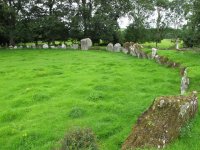oldeuropeanculture
Regular Member

Grange stone circle is the largest standing stone circle in Ireland, 150 feet in diameter and enclosed by 113 standing stones.I believe that Grange circle was originally a threshing floor. I also believe the Grange circle is an example of a threshing floor which was eventually turned into a temple dedicated to the Thundering Sun, the god of weather, god of grain, Crom Dubh, Hromi Daba, Grom Div, the Thunder Giant.
Professor Ó Ríordáin postulated that the circle dated from the Late Neolithic and that it was built c. 2,200 B.C. Archaeologist Helen Roche, however, has suggested that the Grange stone circle was constructed in the Late Bronze Age (c. 1000 BCE) on a site that may have been sacred for thousands of years.
I believe that the building date proposed by Seán P. Ó Ríordáin (2200 bc) is much closer to the actual building date. I believe that the Grange circle was contemporary with the Newgrange and that was certainly built between 3200 bc and 2200 bc. However, additions and changes were probably made in the following millenniums as the worship of Crom Dubh persisted in Ireland up until the arrival of Christianity.
The worship of Crom Dubh or Crom Cruiach, is said to have been brought to Ireland by Tigernmas, sometimes called Tiernmas. Irish annals say that he was a fourth century king and that he was one of the last kings of the Formorians. Tigernmas is sometimes referred to as the “culture king”, because it is said that he was the one who brought aspects of civilisation to Ireland including the cereal farming, smithing of gold and silver, the dyeing of fabrics, and the making of music and art.
Grain farming arrived in Ireland in the fourth or third millennium bc. The Grange circle, the temple of Crom Dubh, the god of grain was built in the third millennium bc. Metallurgy was brought to Ireland in the third millennium bc.
In the 6th millennium bc, in Serbia, mixed together we find highly developed metallurgical Vinča culture and highly developed grain farming Blagotin culture. These two cultures had to be in contact with each other. Vinca houses had grinding stones and bread baking ovens. Is it possible that from the 6th millennium bc, metallurgy and grain farming spread together into Europe from Serbia? And if so did they reach Ireland together, brought by the same people, Fomorians, people from Pomorje, the land by the sea, South Baltic, known today as Pomerania?
If this is the case, then Tigernmas didn't live in the 4th century ad, he lived in the 3rd or 4th millennium bc. Is it possible that the Irish oral tradition has preserved records of events that happened 5000, 6000 years ago? Is it possible that metallurgy arrived in Ireland earlier than we think, at the same time when grain farming arrived? Or did grain farming arrive in Ireland later than we think, at the same time with metallurgy? Is Crom Dubh 5000 thousand years old deity and is Crom Dubh, Hromi Daba, Grom Div the oldest European God who is still celebrated in Ireland and Serbia?
You can read more here:
http://oldeuropeanculture.blogspot.ie/2014/09/grange-circle.html

